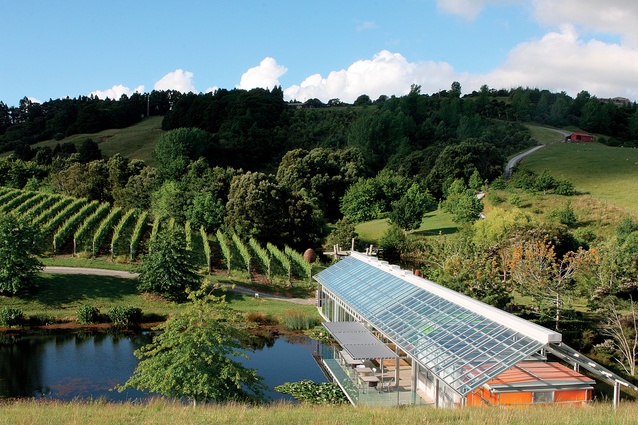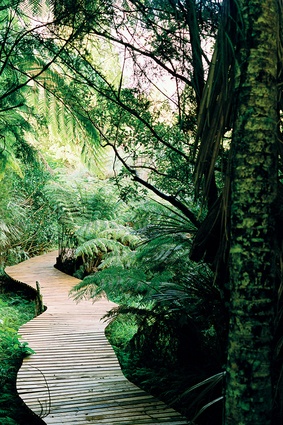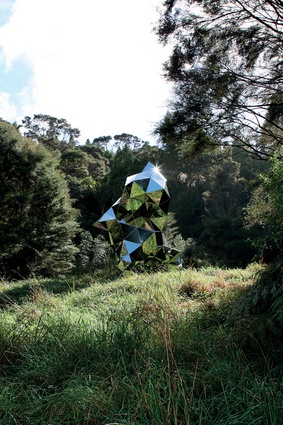Brick Bay
This divergent landscape whose inherent sum, Garth Falconer says, is far greater than its parts, is the result of evolving collaborations over a period spanning nearly three decades.
Continuing the discussion begun in my article on Gibbs Farm regarding highly designed rural farms; Brick Bay Farm, located on the coast between Snells Beach and Sandspit near Warkworth, is a 150 hectare example of a contrasting approach, perhaps more informed of a landscape tradition.
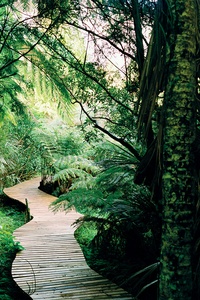
My contention in the previous article was that most contemporary sculpture parks follow a modernist paradigm and largely ignore, to their detriment, several centuries of landscape design practise and cumulative tradition.
Changing the land on a large scale – whether as an expression of technological control or as a freedom from production – has a lot to do with power and the conception of what matters. Three hundred and fifty years ago, Frenchman Andre Le Notre was a forerunner of the professional landscape architect. Son of the royal gardener and trained in the arts and sciences including engineering and astronomy, his innovations for the design of the grand canals of Versailles for Louis the XIV included aligning the central canal to the mid-summer sunset and moving water uphill via a network of windmill- and horse-powered pumps.
A century later, an English theatre designer named William Kent would start to rearrange ‘nature’ to achieve an ideal form and convey social meanings connecting to classical culture. When the landscape park moved to town in the mid-nineteenth century as a powerful urban intervention to ameliorate and sustain city life, it left the rural environment largely to the concern of increasingly productive farming. Perhaps the current renewal of attention on ecological parks in cities and sculpture parks in rural settings represents a full circle, back to the drawing board for new ways of making our world.
Fast forward to Brick Bay in1986. Auckland couple Richard and Christine Didsbury bought what was a rough runoff block of land as a spacious weekend retreat. The property got its current name from an early brickworks on the small beach, which overlooks Kawau Island. The farm extends up a series of longish ridges and valleys that run east-west into a larger catchment of regenerating coastal forest. Mainly in poor kikuyu grass, there was little planting on the block and much erosion on the steeper slopes. They had a farm manager on site and to make the farm work they started off raising Angora goats, which seemed to be reasonably profitable for their wool until the market collapsed, along with the Auckland property market. Little happened on the farm for a long while and its income was subsidised from the owners’ inputs.
In an effort to improve the farm, I got involved in 1994 on the recommendation of architect Noel Lane and the work we were doing on the Gibbs Farm. Richard Didsbury was rebuilding his property development career in the form of Kiwi Income Trust. They had roughly formed a couple of ponds in the valleys but even they were leaking.
So we started with a baseline ecological planting programme to integrate with the surrounding forest habitat, address the erosion, and add to the experiential activities to the farm. Using minimal resources, the first season concentrated on planting out the steepest slopes, which were mostly south facing. This involved fencing off large sections and planting mostly manuka with a mix of puriri, tairare, karo and flax. Poplar poles were also introduced for quick scale and wind protection.
Clumps of tree planting were spread out to break up the large paddocks, which were being grazed by sheep. These featured short term banksia tree species interplanted with longer term natives, mostly puriri.
The other less functional move was to realign the road to the proposed house site that was located on the coastal headland. The existing gravel road took the shortest route, directly from the entry down the nearest ridge to the headland. To increase the experience of engagement and to reveal more of the farm landscape, the road was laid out to weave its way into the centre of the farm heading west then back east below the ridge. At the entry we designed a figure eight layout to further enliven the procession – as the owner found out on the first time he entered the figure eight, if you went on the wrong way you were directly back out again. This was a nod to the serpentine strolling paths of the English landscape tradition.
From there began a yearly programme of works where we would meet at the end of January and discuss the strategy for the year. I would return with sketch proposals mostly sketched in three dimensions and a bulk planting list that would then be implemented by the farm manager in the autumn. Each year the ambitions were raised and the Didsburys would add new ideas to the mix. The first of these was the introduction of a boutique vineyard on the western inland section of the farm.
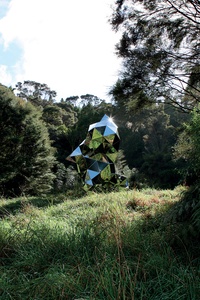
This was relatively new to the area, and they further experimented with a new variety Pinot Gris.
The house was constructed in 1996-97 and led to a concentration of efforts to create a large adjacent orchard of olive trees, tropical fruiting plants (bananas, passionfruit, avocados) and citrus. Feature garden areas around the tennis court on the other side of the house were constructed using palms and succulents. These moves were recalling the tradition of the ‘ferme ornée’ or ornamented farm, a pastoral paradise where aesthetic concerns were developed alongside farming.
We made further ponds in the bottom of the remaining valleys and planted wetland plants and deciduous trees. We made wharfs and walkways as focus areas. We also started the creation of a large perched valley, which we called the ‘Lost World’ featuring old araucarias contrasting with other strange looking foliaged plants such as taro and lancewoods.
In 2000 with the bulk of the planting established I proposed a large earthwork at the base of one of the central valleys on the site of their daughter’s cherished pony ring. It was in the form of a spiralling hill. To my utter dismay, or to check my growing ambitions, the Didsburys then took this idea to artist Virginia King whose first draft was very undeveloped. I showed her examples of more spatially diverse forms, which she picked up on. All the credit has been given to her of course. She also created by herself a bridge through a swathe of raupo, using fishing rod canes with bells that jangle as you walk on the see-sawing boards, which I admit was very cool. The Didsburys must have felt sorry for my wounded pride and allowed me to construct a pet idea that I had tabled earlier that year of an abstract Kauri dam at the base of the Lost World. Working with the talented wood butcher Sam Simonsen, the structure just happened to be built twice as large as they expected.
In 2002 there was the addition to the farm of a further 60 acres to the western end, which daylighted with a road access near Snells Beach. This created the opportunity for the Didsburys’ next big move – like the Gibbs they had started to commission large works from artists including Chris Booth and Phil Dadson. But they took another direction, adopting an idea they first saw in England to set up a public sculpture walk where artists would be invited to display their works for sale to the paying public, with the returns going into funding the introduction of young up and coming artists. They constructed a winery building, in the form of a glasshouse designed by Noel Lane, to showcase their award winning wines, and to anchor the sculpture walk, which wound its way around two of the ponds we had made. Their daughter Anna returned from viticulture studies to design and run the sculpture walk.
The combination of winery and art, as the brochures put it, has been a compelling mix and the facility now employs six people. The farm manager has a permanent staff of just two and relies on the seasonal use of ‘wwoofers’, young travelling workers.
After 20 years of ‘improvement’ Brick Bay Farm is more than self sustaining, more than winery and art. The collaborative and staged process has allowed for a range of inputs and constant evolution. It has developed an integrated form with productive uses, a diverse range of activities and aesthetic pleasures, and the health of the land is in a very fit state, with part of the property open to public seven days a week. Its collective meaning has been informed and extends past those of just a farm, a park or an outdoor gallery. By design, Brick Bay is a rich and divergent landscape, a place whose inherent sum is much greater than its parts.

